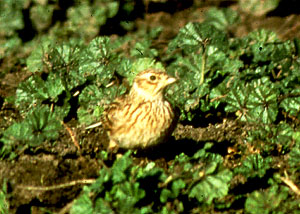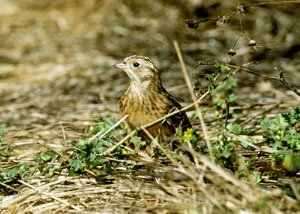
© Albert Ghiorso

© Peter LaTourrette
Don Roberson correctly identified these specific individuals and wrote,
"I'll not add public comments, since I recognize the birds and the exact locales, but your quiz photos are great showing THE Skylark next to THE Smith's Longspur. Very nicely done, and a nice choice of photos which obscure numerous helpful marks. Very amusing!"
Don's chronology of the initial identification of the Point Reyes bird is accurate and very much worth reading. In fact, the reasons Don relates for why the bird was not a Smith's Longspur are excellent hints to solving the identity of both of these birds. The story is legendary, but the facts have never before been published. I was also seduced into the "mass hysteria." and can add some additional background. Binford first came to doubt that the Point Reyes bird was a Smith's Longspur after checking the plumage descriptions and keys in "Birds of North and Middle America" by Robert Ridgway (1901). Ridgway's key distinguished the Smith's Longspur by "Abdomen buffy or ochraceous, like rest of under parts...." vs. "Abdomen white...." for the other longspurs. Ridgway was writing for museum curators who see specimens lying on their backs, so this difference would be obvious in the museum tray. In the field these birds crawl along low to the ground, making such differences more subtle. Yet, I believe the difference is fairly clear in these photographs and that was the point I wanted to make by juxtaposing them here.
When Don called to tell me about the Moonglow Dairy bird, I remembered Smith's Longspur was was supposed to be all buffy below. This longspur had been found and tentatively identified by Doug George, a local birder who had never seen any species of longspur! Don's experience with the Sky Lark was critical in confirming Doug George's find. Interestingly another observer had passed this same bird off as a Vesper Sparrow the day before. There are lessons here for all of us.
More recently there has been confusion between Lapland Longspur and Smith's Longspur. E.g. the Smith's Longspur at the CBRC photo gallery at Furnace Creek in Death Valley in October 1997 was originally misidentified as a Lapland Longspur. Notice the strong white wing-bars on the Death Valley Smith's Longspur. These are not found on any plumage of Sky Lark. This critical feature is not visible in the photo below, but the bird definitely had them.
For distinguishing longspurs, I can do no better than to echo Steven Mlodinow's recommendation of the wonderful paper by Jon Dunn and David Beadle Longspurs- Distribution and Identification in Basic Plumage. (Birders Journal 7:68-93, 1998). For more on the Sky Lark, see Morlan, J. and R. A. Erickson. 1983. A Eurasian Skylark at Point Reyes, California, with notes on skylark identification and systematics. (Western Birds 14:113-126, 1983) .
Which finally brings me to the subject of the subspecific identity of the two Sky Larks which were found this winter at Sequim, Washington. They were thought to be of the Asiatic race Alauda arvensis pekinensis like the Point Reyes bird below rather than the race A. a. arvensis which has been introduced at nearby Vancouver Island and which has expanded to the San Juan Islands in Washington. Photos of the Sequim birds contributed by Ruth Sullivan may be seen on our photo gallery.
Before getting down to cases, it is important to understand that the differences between the various subspecies of Sky Lark are rather minor variation in size and pigment saturation. Males are larger than females within each subspecies. Furthermore, it is my opinion from examining specimens, that there is as much individual variation within subspecies as there are differences between subspecies in this group. In other words, the Sky Lark races have been over-split. In the case of the Point Reyes bird we were able to get it down to being a member of the the "pekinensis group" which consists of several named subspecies, some of doubtful validity , and this was accomplished only by consultation with experts at the British Museum.
While the Sequim birds do seem to be fairly heavily pigmented, they do not appear to me to be a good match for the Point Reyes bird. In particular, they show excessive wear on the tertials, scapulars and mantle. In this respect they closely resemble some photos I have of birds taken in the summer in Europe. The Point Reyes bird never exhibited this type of wear. Also the Sequim birds seem to be more contrasting white around the eye and on the throat while the Point Reyes bird was buffier overall. I understand that some observers from Europe have expressed the opinion that the Sequim birds do not look like birds on the British Isles, but I think we really need to compare them to the nearby population on Vancouver Island which has been established for over 60 years. With the amount of individual variation expected, it is certainly possible that this small isolated population may have evolved characters somewhat different from its ancestors in Europe. E.g. Sky Larks along the Asian coast tend to be buffier than those slightly inland, and the same environmental forces could have affected the birds in British Columbia.
Although the Sky Larks on Vancouver Island are not migratory there is a fair amount of ferry boat traffic between Sequim and the San Juan Islands as well as Vancouver Island. It is possible that the birds might have been transported by boat. Also the extensive wear visible on the Sequim birds might possibly have been caused by being held in a cage. One bird clearly shows a broken tertial tip, but all the scapulars and coverts look heavily abraded.
In any event, I think it would be worthwhile to compare the photos of the Sequim bird directly with birds currently on the San Juan Islands, before reaching any firm conclusions.
Thank you to all who participated in the excellent and lively discussion. Special thanks to Don Roberson and David Fix who commented on an early draft of this analysis. The original mystery photos are below:
© Albert Ghiorso |
© Peter LaTourrette |
What do you think these birds are? Please click here to view comments or add your own. Thank you very much for contributing your thoughts.